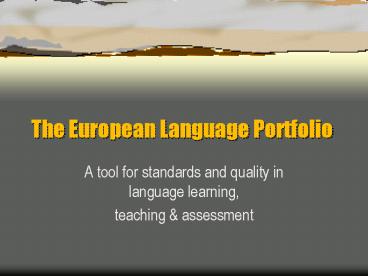The European Language Portfolio - PowerPoint PPT Presentation
1 / 18
Title:
The European Language Portfolio
Description:
to encourage reflection on one's own language learning progress and achievement ... Audio cassettes. Videos. Computer programmes etc ... – PowerPoint PPT presentation
Number of Views:33
Avg rating:3.0/5.0
Title: The European Language Portfolio
1
The European Language Portfolio
- A tool for standards and quality in language
learning, - teaching assessment
2
Portfolios 1
- Aims
- to give added value to language learning
- to promote plurilingualism
- to encourage reflection on ones own language
learning progress and achievement - to contribute to the mobility in Europe of
workers and students
3
Portfolios 1
- Aims
- to give added value to language learning
- to promote plurilingualism
- to encourage reflection on ones own language
learning progress and achievement - to contribute to the mobility in Europe of
workers and students
4
Portfolios 2
- The concept
- Transparency enhances language learning
- Self-assessment and reflection are essential
features of successful language learning - A common system of levels contributes to setting
clear objectives and comparing and assessing
results
5
Portfolios 3
- Rules for all portfolios
- They belong to the learner
- They must be validated by the Council of Europe
- They have three sections
- A Language Biography
- A passport
- A dossier
6
The biography
- An account of the learners language learning and
language use - The language spoken at home and by parents and
grandparents - School language learning
- Languages learnt outside the school on holiday,
trips, with relatives - Language learning priorities
7
The Passport
- Official evidence of language competence and
knowledge - The passport is standard to all recognised
passports and is based on the Common Scale of
Reference - It record
- Diplomas and certificates
- School language learning results
- Inter-cultural experiences
- Self-assessment
8
The dossier
- Contains personal work of the learner who chooses
what s/he wants to put in - Projects
- Written work
- Audio cassettes
- Videos
- Computer programmes etc
- Learners change the contents as their skills and
knowledge develop
9
Some questions
- Portfolios are expensive in money and time is
it worthwhile? - Is self-assessment reliable?
- Do learners want continuous self-assessment and
discussion of the learning process? - Will employers and educational institutions use
and recognise it?
10
Some responses
- Piloting has shown very positive acceptance from
learners, especially young learners, who see it
as giving prestige and value - Self-assessment gives very reliable results in
comparison with exams etc. - Employers and universities generally welcome a
standardised system of recording language
achievement
11
The Common Scale of Reference
- The Common Scale of Reference is the core of the
cef. - It describes user competence at 6 levels
- Basic user A1 (Breakthrough) A2 (Waystage)
- Independent user B1 (Threshold) B2 (Vantage)
- Proficient user C1 (Effective proficiency) C2
(Mastery)
12
A Basic user
B independent user
C proficient user
A1
A2
B1
B2
C1
C2
13
Levels can be sub-divided
- The levels are too broad to show progress over a
short period, so you can sub-divide them. The
Swiss education system has six levels up to B1
(A1.1, A1.2, A2.1, A2.2, B1.1, B1.2) for
compulsory schooling up to the age of 16.
14
How much vocabulary do you need?
- A2
- B1
- B2
- Around 850 words
- Around 1500 words (Threshold level)
- Around 4500 words
15
Examples of descriptors 1
- A1 Can understand and use familiar everyday
expressions and very basic phrases aimed at
satisfaction of needs of a concrete type. Can
introduce him / herself and can ask and answer
questions about personal details, such as where
he/ she lives, people he/she knows and things
he/she has. Can interact in a simple way provided
the other person talks slowly and clearly and is
prepared to help.
16
Examples of descriptors 2
- C2 Can understand with ease everything heard or
read. Can summarise information from different
spoken and written sources, reconstructing
arguments and accounts in a coherent
presentation. Can express himself / herself
spontaneously, very fluently and precisely,
differentiating finer shades of meaning even I
more complex situations
17
The importance of the scale
- Its been adopted by ALTE (UCLES, Goethe,
Alliance Française etc.) and will be used as the
level descriptor for their exams and equivalences - A number of countries are using it / going to use
it as a basis for school language certification
(France, Italy, Finland) - The European Language Portfolio is based on it
and the self-assessment scale - It will affect the levels used in coursebooks etc.
18
Task one placing learners on the scale
- Choose a language or languages that you have
learnt as a second or foreign language - Look at the Scale of Reference to estimate your
broad level - Check the self-assessment grid to see if you have
different levels for different skills - Use the checklists to fine tune your
self-assessment - Compare your results / reactions with your
partners































